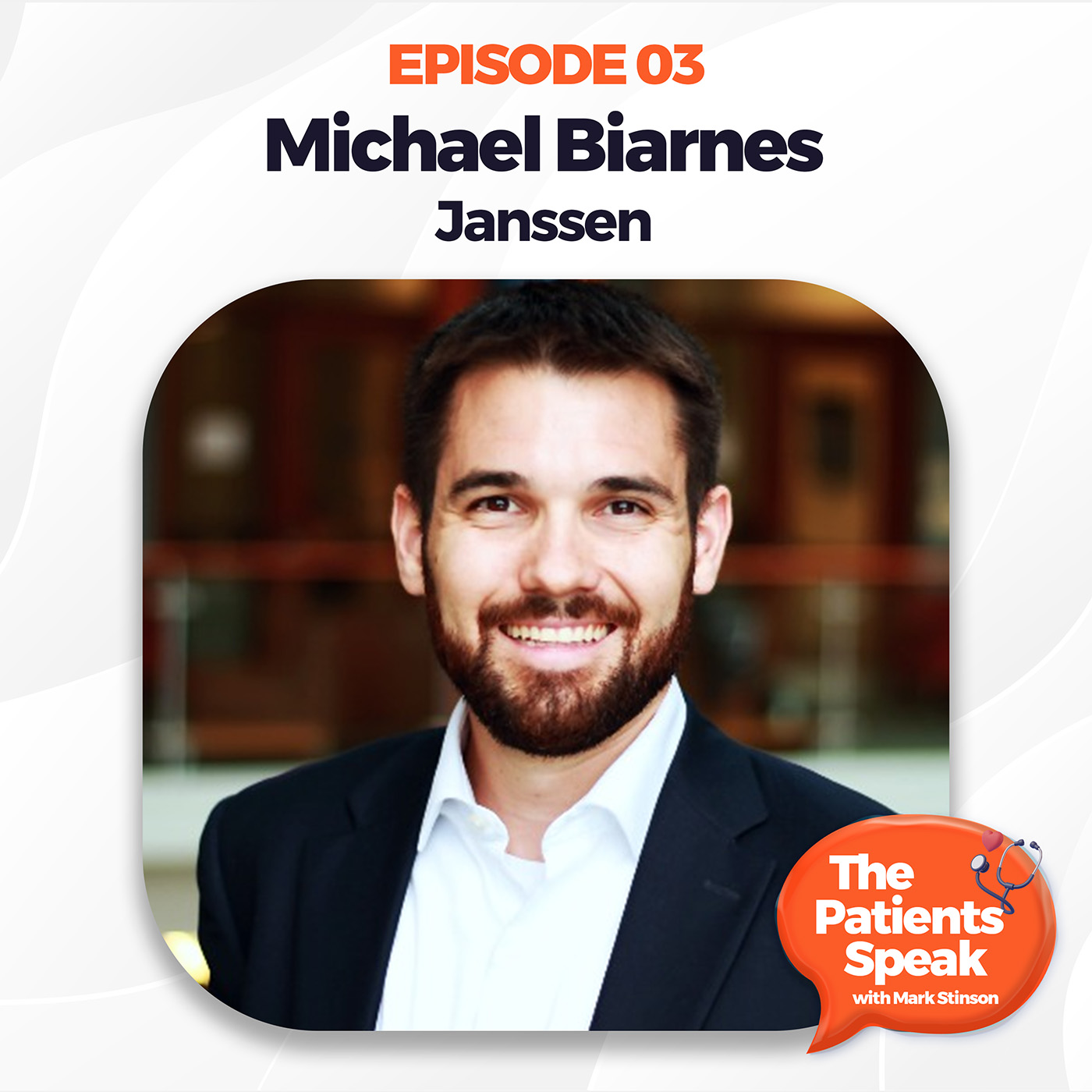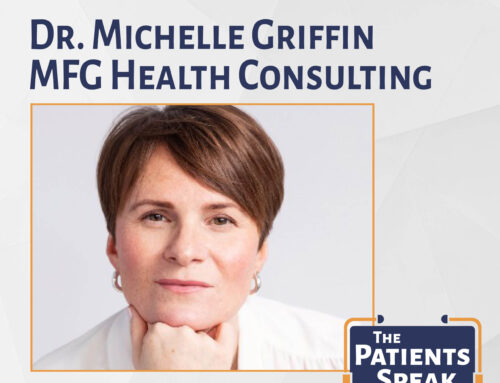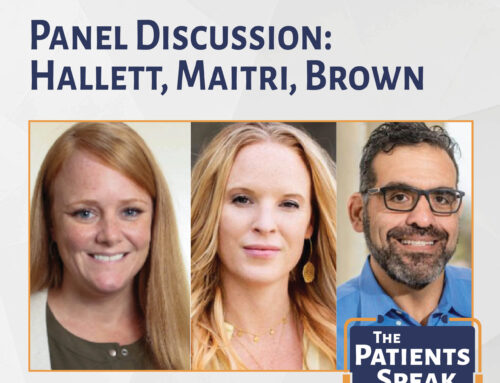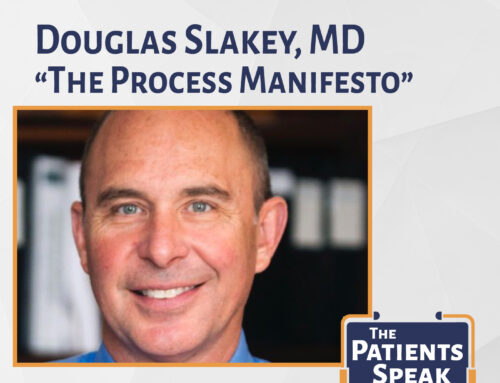Welcome to one of the first episodes of our new podcast, The Patients Speak, where we combine business and science innovation with how patients need to be represented in research and marketing. One of the topics we discuss today is how to make sure the patient’s voice is heard all through that research process, on into the development and commercialization of new products, with our guest, Michael Biarnes.
Michael is the Manager of New Products and Business Development at Janssen, one of the pharmaceutical companies of Johnson & Johnson. He is also the author of Redefining Success: Stories, Science, and Strategies.
Mark Stinson, host:
My guest is Michael Biarnes. He’s Manager of New Products and Business Development at Janssen.
Michael Biarnes, guest:
The biggest thing is put yourself in the shoes of the patient and seek out some of those patient stories and you’ll incorporate patient voice into every conversation. I don’t care what function you’re in, you can do that. You can say, well, is this best for the patient? Is this going to improve our ability to help a patient down in the future?
Mark Stinson, host:
Hello, friends, and welcome to one of the first episodes of our new podcast, The Patients Speak, where we combine business and science innovation with how the patients need to be represented in research and marketing and outreach. One of the topics we’re going to discuss today is how we make sure the patient’s voice is heard all through that research process, on into development and commercialization of new products, with my guest, Michael Biarnes. Michael is the Manager of New Products and Business Development at Janssen, one of the pharmaceutical companies of Johnson & Johnson. Mike, welcome to the program.
Michael Biarnes, guest:
Thanks so much for having me, Mark. It’s great to be here.
Mark Stinson, host:
Well, Mike, you’ve worked in cancer research, clinical diagnostics, neuroscience, cardiovascular disease. I just look across the breadth of the categories and the functions that you’ve had. How have you made sure that the patient’s voice is heard?
Michael Biarnes, guest:
Yeah, I’ve been very fortunate in the kinds of opportunities that I’ve had so far in my career. It’s been about over a decade now, somehow. Goes quick. But I can tell you that no matter what role I was in, the patient was at the forefront. And that goes to what you’ve already alluded to. Foundational, basic research at a breast cancer center at an academic institution, looking at drug target discovery. There we’re looking for unmet need, can we find patients and better diagnose patients looking for drug targets, potentially, or even biomarkers … To a diagnostic company. Again, very heavily involved nowadays in precision medicine. Can we make sure that the right medicine goes to the right patient by introducing diagnostics, new biomarkers, new signals, to make sure that doctors and patients can make informed decisions.
To even at the nonprofit where I was managing strategic partnerships between large pharmaceutical companies, hoping to enroll clinical trials, leveraging partnerships with FDA, NIH, and how can we develop these broad-based partnerships to better inform our clinical trial design and execution. And how, obviously, in the pharmaceutical sector, the patient is at the center of everything that we do. I can tell you being in new product development, we get patient insights every step of the way, and we try to make sure that any decision that we make has the patient at the center of every single one of our decisions.
Mark Stinson, host:
Oh, that’s helpful. I think when you’re talking about inclusion-exclusion criteria, patient condition, and demographics, but let’s get down to the patient connection. Now, what are some of the channels or methods that you’ve found helpful to really bring the patient to life in either some of those meetings or some of those strategies?
Michael Biarnes, guest:
Yeah. So when we have the opportunity to, I’ll try to incorporate aspects from all walks of life. The nonprofit was a really interesting role that I had because we had the opportunity to bring in patient advocacy groups, have patient voices brought into our conferences and meetings. They were representing themselves and advocating for themselves and their peers, that were struggling with a given disease.
I can tell you, even in the pharmaceutical sector, we have a patient advocacy arm where their entire mission is to engage with advocacy groups, understand what the needs are. They, in a very compliant way, talk with patients and engage in patient advisory counsels, who can tell us where are their pain points along their patient journey; whether that’s in the diagnosis, whether that’s in fulfilling a medication or getting the right medication access to medication. So that’s the advocacy arm.
I can tell you, regardless of whether that’s the marketing arm or whatever, medical affairs, we have all sorts of teams within our company, each and every one of them is trying to incorporate patient insights, the patient voice, into our decision making to ensure that as we are developing a new product and bringing it to market, we do it thoughtfully and we’re doing it to address those pain points and make whatever disease or condition we’re working on, for that patient’s journey to have an improved outcome.
Mark Stinson, host:
Yeah. Thinking about even the word “pain points,” it’s a vernacular that we like to use in business, but it really is a placeholder for, this is something going on in the real life of the patient. Can you think of a story or an encounter you might have had with a patient or a patient group where their story really did impact you and maybe even change the direction that you were taking?
Michael Biarnes, guest:
Yeah. I can tell you when we brought in, it was a patient to talk about, it was Alzheimer’s research that we were doing. And we were trying very hard to make sure that we had diverse groups represented in our trials at that time. We had someone come in and talk about the history of their experience, their family’s experience with physicians, with the healthcare system, generally. It really brought to light how we need to better engage, not just with patients, but with communities, community leaders, folks who are very well trusted individuals. Because unfortunately, there are massive disparities of health depending on where you live and you may or may not have been treated better or worse depending on where you’ve tried to go and get care.
So it’s our responsibility to help improve access for everyone, not just those who live next to the big, new, shiny institution that has all of the great resources. We need to engage those individuals in a way that will bring forth the right voices, the trusted advisors, the trusted community leaders, to ensure that individuals know of the types of care that can be achieved, no matter where you are, no matter where you live, no matter what demographic you might have.
Mark Stinson, host:
You’re bringing up some of these health gaps, these disparities, and again, we’re focused a lot these days on diversity and equity and inclusion, especially in clinical trial recruitment. What are some of the things that you’re seeing that are helping the recruiters of clinical trials improve their reach, be more inclusive, improve that diversity?
Michael Biarnes, guest:
So a lot of it is this engagement with broader communities trying to understand the stakeholders who are truly leaders to a given community, to a given population. Right? People who are trusted advisors and building those relationships. It takes time and it takes effort. It’s not just a simple marketing campaign. This means face-to-face interactions, dealing with key opinion leaders, and making sure that you’re not just talking about a product, you’re talking about education. So disease state awareness, understanding the patient journey and bringing, as you said, pain points, but making it known that these issues are not just theirs. That these are shared experiences and that we’re trying to listen and we’re trying to make improvements. So it goes to a lot of this patient education early and often, and just trying to get as much engagement with the key stakeholders as possible.
Mark Stinson, host:
I know the presenters of this podcast, 83bar, are engaged in that kind of education, so I wanted to pull on that string a little bit more. You’re almost describing this trusted intermediary in the community. That it’s not simply a maybe company or sponsor to patient directly, but there’s some sort of community member, an intermediary. Tell me more about what you’re saying there.
Michael Biarnes, guest:
Yeah. So it’s highly dependent on the therapeutic areas, what I’m seeing and the disease. You see some diseases where the patients really trust their doctors to make the right decisions for them, because it could be really scary, life-threatening, and they feel like that’s the best trusted source that they have.
There are other instances, whether it’s due to how folks have been treated in the past or whether … some of those disparities that we talked about, where we do need to engage unique members. We’ve heard things from community centers, pharmacists, nurse practitioners, at-home nurses, or depending on the demographic, it could be folks that work in elderly care. It’s making sure that you’re engaging with the folks that deal with the patients the most and who the patients trust. So it’s again, getting out there, talking to as many patients as possible, understanding what does their day-to-day look like? How do they live with their disease? Who do they engage with and who do they listen to? And then making sure that we’re educating across all of those stakeholders that they identify. Unfortunately, there’s no one stop shop answer. Right?
Mark Stinson, host:
Because the categories can differ. Yes.
Michael Biarnes, guest:
Yeah.
Mark Stinson, host:
And even maybe engaging churches, schools, nonprofits, and so forth.
Michael Biarnes, guest:
Right.
Mark Stinson, host:
That’s very interesting. Well, the fields you’re working in couldn’t be more important” cancer, neuroscience, cardiovascular. Give us a glimpse, obviously, non-confidential.
Michael Biarnes, guest:
Sure.
Mark Stinson, host:
But give us a glimpse on some of the cool directions and the exciting developments that you’re seeing in some of these areas.
Michael Biarnes, guest:
Yeah. The one thing that I’m really, really excited about is that this movement towards precision medicine. And it’s been about a decade now, right? You’re seeing a whole lot in Oncology. It’s no longer acceptable to just say, “Okay, we’re going to give you a broad chemotherapeutic.” It’s going to be very terrible, tolerate it, lots of side effects. And we’re going to give the same treatment to everyone. Now it’s, what biomarkers do you have? What mutations do you have?
What that does is that gives you a very narrow range of patients where you know, based on your clinical trial, that your product will give you the best efficacy with the best safety profile. So it’s this idea that by understanding the science at a deeper level, going back to my academic days of drug target discovery, understanding that basic science, translating that all the way through the drug development process, to make sure that we’re incorporating the right biomarkers, to ensure we’re stratifying patients, understanding the disease as well as possible, and making sure the right patient gets the right product.
So that’s what I’m seeing heavily in Oncology. You’re seeing a big push in several different rare diseases right now. There’s 7000 different rare diseases that end up afflicting, I think, it’s over 10% of the population across all of them. Right? But each one is so tiny, but because of that, then you have an opportunity to really hunker down and understand that disease and make sure that you’re trying to get something novel, something innovative, something impactful to those patients.
The other thing that I really am excited about is Neuroscience. You can read papers all the time where the neurodegenerative space, so Alzheimer’s, Parkinson’s, ALS even, is in the same grounds as where oncology was about 20 years ago. A lot of foundational work going into better understanding those diseases, understanding how to best stratify the patients, and understand what’s unique about each of them. Not treating them all the same. Though a lot of that foundational work’s being done now, so I’m really excited to see what comes out in terms of innovative treatments and care for those populations in the next five to 10 years.
Mark Stinson, host:
Well, and your background includes, as you mentioned, collaborations with research groups of all kinds, even with the NIH. There are so many creative partnerships out there right now. Companies that you thought would never cooperate, let alone collaborate, sign cooperative deals. What are you seeing in this area as far as creative team-ups?
Michael Biarnes, guest:
Yeah. So across the boards, I’ll speak to neuroscience because that’s where I was working in those very unique spaces. To your point, you’d never think that some of these major competitors would come together and collaborate in the ways that they do. We’re talking about massive initiatives to share clinical trial data and really do a deep dive of, well, why are our clinical trials failing? You look at Alzheimer’s, you have some of the worst approval rates in any therapeutic area. I think it’s about 2% approvals across all of Alzheimer’s. And so companies are realizing they can’t do it alone anymore. The problem is too big. And frankly, companies aren’t willing to take on the risk by themselves. So what you see is these really innovative partnerships where companies are coming together and saying, okay, what would help us improve our odds of getting a product to patients? Something that will truly make a difference.
And it’s understanding that science and it’s often sharing data, it’s potentially doing some new prospect studies and we did recruitments. We did, can we assess different ways to measure different biomarkers and see which ways are best? So we just published the data. We make it very publicly available. I was involved in literally one of the largest natural history studies of all time called the Alzheimer’s Disease Neuroimaging Initiative. It’s been going on for 15 years, looking at longitudinal data for patients trying to understand Alzheimer’s progression, understanding again, how do we stratify these patients, make sure that the right patients get into our clinical trials and that we can actually make an impact for folks. So you see these really big problems that are trying to be tackled, and to de-risk the solution finding and make sure that we’re just not abandoning those disease areas. The companies are coming together and trying to find solutions, so that then they can go and take that data and create the products on their own on the back end.
Mark Stinson, host:
Yeah. Seems like a very positive development. Well, my guest is Michael Biarnes. He’s Manager of New Products and Business Development at Janssen. And, of course, Mike is speaking on his own behalf and his own opinion. He’s not speaking for the company. Which brings us to the question then, Michael, as you think about the future, periscope a little bit for us, where’s the next step in really bringing more patients into clinical research or trying these new and innovative solutions?
Michael Biarnes, guest:
Yeah. So I see a big push right now and I think it’ll just continue to grow in technology. So every day we carry around a miniature computer in our pocket, right? And there are all sorts of wonderful companies and biotechs that are creating applications for patient reported outcomes, which are being heavily utilized within clinical trials. But also, like me, I have a fitness tracker, right? A Fitbit on. Things like that are being used to monitor sleep patterns. If it’s a neurodegenerative disease, it can measure shaking, it can measure how you’re breathing, how you’re talking. There are ways that people are now tracking the way that you interact with your computer depending on software. So is your mouse trembling a little bit more than it used to? Is it taking a bit longer for you to get to the right applications than it used to?
And again, it’s this longitudinal data where you’re looking at a patient, establishing a baseline, and getting to understand what normal looks like to them so that you can understand, are they progressing? Are they worsening in whatever disease they might have or maybe it leads to a new diagnosis. So it’s going to be incorporating technology into our day to day, which enables us to better engage with patients long-term. It’ll make it easier for them. They don’t have to go to the doctor all the time, if they want to report their symptoms, how they’re feeling. I think that’s the future of how we can get more folks involved in clinical research.
Mark Stinson, host:
Very good. Well, we’d be remiss if we didn’t touch on something, a personal project of your own Mike, and that’s your book, Redefining Success, great leadership, personal development book. But I wanted to tie this together maybe in our discussion. Chapter 11 is entitled, Be like a scientist and run some experiments. If we’re really developing our own emotional intelligence, especially as we listen to patients, how can we run some experiments, try new things to be better listeners?
Michael Biarnes, guest:
So I love the title of that chapter because the intention is it can fall to any walk of life. Right? The idea is, don’t just dismiss something because either it sounds hard or complicated or something that you wouldn’t enjoy at all. You never know until you try something, if you’re going to like it or not, or if it’s going to be an easy experience, a good experience. So there are all sorts of wonderful ways to get involved in healthcare as just a normal individual. So the first ways, you can start to just educate yourselves. That’s easy, right? Low hanging fruit, just you can pick up. There are all sorts of articles, great resources out there. But the other thing is to start engaging in research, right? We’re always trying to recruit new individuals. It could be healthy volunteers to engage in developing some of these web applications that we’re talking about.
Things on your cell phone. It could be a game. There are literal games on your computer that, potentially, as part of a research study, a research participant, they might even pay you to be part of this, to just interact in a game. And you can be a healthy volunteer potentially, and it’s helping us develop new novel techniques to improve patients on the back end. And so I like to say that especially in this country, we like to wait until something goes wrong to seek treatment, right? Unfortunately, that’s what a lot of us are primed to do. But if we can get a little more proactive and, obviously, you engage in your primary healthcare provider, engage in some of these research studies, you’re going to help move the needle for the future so that we can continue to innovate, continue to bring things to patients and improve patient outcomes long-term.
Mark Stinson, host:
And I love the subtitle of your book that includes Stories, Science, and Strategies.
Michael Biarnes, guest:
Yeah.
Mark Stinson, host:
Which is almost something to underscore from our discussion today, isn’t it? That we need to bring those patient stories and combine them with the science.
Michael Biarnes, guest:
Yeah. It’s all about storytelling. You don’t need to get too … especially the general public. As soon as you start talking too much about science, you need to be able to say it in a relatable way. And the best way to do that is to bring stories, patient insights, literally, real life perspectives to the forefront. As soon as you do that, people start to listen. People start to care. You bring emotion into it. And that’s what it’s all about. In the end, no matter what we do on a day to day, it’s about improving that person’s life. So that when they tell their story, they can end it on a positive note and say well, because of this product or this new innovation, I feel a lot better today. And I’m able to live my life in a better way. And so, got to bring those stories to life.
Mark Stinson, host:
Well, Mike can’t thank you enough for this great discussion. My guest has been Michael Biarnes. He’s the Manager of New Products and Business Development at Janssen, a pharmaceutical company of Johnson & Johnson. He’s also the author of a leadership book called, Redefining Success, Stories, Science, and Strategies.
Michael Biarnes, guest:
Thanks so much for having me, Mark. This is great.
Mark Stinson, host:
And thank you listeners for coming by our new podcast, the Patients Speak. We want to thank 83bar for making this podcast possible and really raising all of our awareness to listening better to what the patients have to say. I’m Mark Stinson. Come back again for our next interview. I’m talking with another healthcare executive about what they hear when the patients speak.





